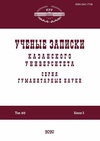Договор 358 г. до н. э. между Римом и латинскими общинами
The Treaty of 358 B.C. between Rome and the Latin Communities
Author(s): Ludmila Mihailovna ShmelevaSubject(s): Diplomatic history, Political history, International relations/trade
Published by: Казанский (Приволжский) федеральный университет
Keywords: foreign policy; Gauls; Latins; Etruscans; Latin League; Roman Republic; foedus Cassianum;
Summary/Abstract: This article considers the international position of the Roman Republic during the first half of the 4th century B.C., from the Gallic invasion to the conclusion (or renewal) of the union treaty with the Latin League in 358 B.C. Rome’s relations with the Latin communities and neighboring tribes and states are analyzed. The ways used by it to establish and maintain its hegemony in the region of Central Italy are discussed: unleashing war, granting citizenship rights, and removing colonies. It is worth noting that the Romans were more inclined to choose war. Special attention is paid to the agreement of 358 B.C. that eventually formalized and enshrined the unequal position of Rome and the Latin communities. Interestingly, the ancient authors did not cite the text of the treaty, but the subsequent events show that Rome and the Latins either had entered into a new treaty or renewed the old one. The historiography speaks of a new agreement between them, and this agreement was concluded on more favorable terms for Rome. From the events that unfolded in the second half of the 4th century B.C., it becomes clear that the new conditions were the obligation to supply Rome with military contingents and the use of the resources of the Latin communities to support the Roman conquests.
Journal: Ученые записки Казанского университета. Серия Гуманитарные науки
- Issue Year: 164/2022
- Issue No: 6
- Page Range: 130-138
- Page Count: 9
- Language: Russian

